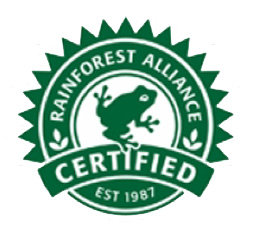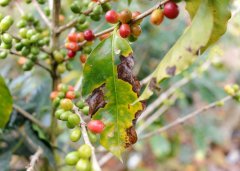Understanding the Rainforest Alliance: to awaken the public to protect the rainforest that was disappearing at 50 acres per minute.

For professional baristas, please follow the coffee workshop (Wechat official account cafe_style)
Rainforest Alliance Rainforest Alliance (RFA) protects the rainforest that disappeared at a rate of 50 acres per minute to awaken the public.
In 1986, the worldwide non-governmental organization (NGO) Tropical Rainforest Alliance was established in New York.
The Rainforest Alliance uses market forces to stop activities that may lead to forest reduction.
Including: farmland expansion, logging animal husbandry behavior, tourism behavior.
The Rainforest Alliance certifies products or services that meet the standards
And believe that the best way to protect the rainforest is to let businesses and communities understand that protecting the rainforest is beneficial.
The Rainforest Alliance is committed to protecting forests, curbing climate change, protecting wildlife,
Reduce poverty, transform business behavior to be more sustainable and protect forests.
In total, there were 250000 farmers worldwide by 2011, and 2.8 million acres in 33 countries were certified by the Rainforest Alliance.
In the case of coffee, 2% of the coffee on the market is certified by the Rainforest Alliance.
The global coffee industry earns $600 million a year, but only less than 10% goes to coffee farmers.
For every cup of coffee sold, most coffee farmers get less than 1%.
There are 25 million coffee farmers and their families in 50 countries who make a living by growing coffee. Many coffee farmers are very poor.
The Rainforest Alliance gives coffee farmers economic incentives to protect sustainable land and help coffee farmers reduce soil erosion
It is kept fertile, the water is clear and clean, and the workers are treated properly.
Coffee farmers certified by the Rainforest Alliance can enter new markets, have higher prices and have more credibility.
At present, 1.5 million of coffee farmers are certified by the Rainforest Alliance.
The global coffee planting area is about 30 million acres, in the 150 years before the 1970s.
Coffee trees are generally planted under natural rainforests.
However, the planting methods that began to be used in the 1970s cleared the woods and turned the coffee trees into dense and neat shrubs.
With the application of chemicals, monoculture has increased coffee bean production, but sharply increased environmental costs.
Traditional planting methods retain many habitats of wild animals, while monoculture reduces their habitats.
Increase soil erosion and pollute water flow.
Rainforest Alliance certification introduces a sustainable farm management system.
(SAN Sustainable Farm-Management) help coffee farmers improve the management of coffee farms
Increase market advantage, enter favorable market, control cost, improve efficiency and crop quality.
Coffee plantations certified by the Rainforest Alliance are of great benefit to biodiversity.
For example, the coffee field in El Salvador contains 100 tree species.
The Rainforest Alliance's sustainable farm management system, SAN, also conserves rare birds, bobcats,
Such as postcard-sized butterflies, brightly colored frogs, rare orchids, monkeys, anteaters.
Coffee farms planted in forests are recognized as important resting stations for migratory birds over long distances.
Rainforest Alliance certification ensures that the coffee farms planted can maintain wildlife habitats and protect the environment.
It also protects the livelihood of coffee farmers.
Rainforest Alliance official website
Http://www.rainforest-alliance.org/agriculture/crops/coffee
Important Notice :
前街咖啡 FrontStreet Coffee has moved to new addredd:
FrontStreet Coffee Address: 315,Donghua East Road,GuangZhou
Tel:020 38364473
- Prev

Boutique Coffee Map | know Ethiopia's ECX-DST system
The exchange of professional baristas please follow the coffee workshop (Wechat official account cafe_style) * in 1984, a drought in Ethiopia resulted in a short harvest, killing about 1 million people, but there were sufficient food stocks at that time, but due to the lack of central management, sufficient food could not be delivered to the scarce areas, thus giving birth to the establishment of ECX. Ethiopia
- Next

Introduction to Jamaica Mavis Bank Blue Mountain NO.1 at Blue Mountain Manor, Jamaica
For the exchange of professional baristas, please pay attention to the coffee workshop (Wechat official account cafe_style) Mavis Bank Blue Mountains NO.1 Jamaica Mavis Bank Blue Mountain NO.1, Jamaica. The Blue Mountain legal coffee producing area in Jamaica is named Blue Mountain because it is constantly shrouded by blue fog. The Blue Mountain producing area is located in eastern Jamaica, spanning 45 km and 20 km wide, with a maximum elevation of up to
Related
- Does Rose Summer choose Blue, Green or Red? Detailed explanation of Rose Summer Coffee plots and Classification in Panamanian Jade Manor
- What is the difference between the origin, producing area, processing plant, cooperative and manor of coffee beans?
- How fine does the espresso powder fit? how to grind the espresso?
- Sca coffee roasting degree color card coffee roasting degree 8 roasting color values what do you mean?
- The practice of lattes: how to make lattes at home
- Introduction to Indonesian Fine Coffee beans-- Java Coffee producing area of Indonesian Arabica Coffee
- How much will the flavor of light and medium roasted rose summer be expressed? What baking level is rose summer suitable for?
- Introduction to the characteristics of washing, sun-drying or wet-planing coffee commonly used in Mantenin, Indonesia
- Price characteristics of Arabica Coffee Bean Starbucks introduction to Manning Coffee Bean Taste producing area Variety Manor
- What is the authentic Yega flavor? What are the flavor characteristics of the really excellent Yejasuffi coffee beans?

